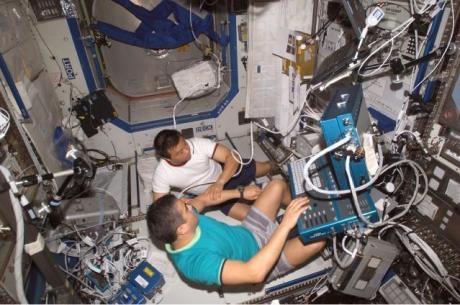Telemedicine: From Space Station to You
Imagine you are on the International Space Station and in need of medical attention – where do you turn? NASA has mitigated the risk of medical emergencies aboard the space station by using on-board ultrasound and earth-based telemedicine consultation. This is not some novel sci-fi concept reserved for elite astronauts. Rather, a technology occurring at lightning speed in rural communities across the U.S.
NASA-funded studies in remote locations around the world have had a direct impact on the development of the space station’s ultrasound program. Likewise, the space station’s extensive use of telemedicine is leading to advances of the technology on earth. Telemedicine includes a growing variety of applications and tools; using two-way video, email, smart phones, wireless tools and other forms of telecommunications technology.
The greatest impact of telemedicine is on the patient, their family and their community. Study after study has documented increased patient satisfaction with the use of such technologies – offering patients access to providers that might not be available otherwise, as well as medical services without the need to travel long distances. In some specialties, particularly in mental health and ICU care, telemedicine delivers a superior product, with improved outcomes and increased patient satisfaction scores.
Reducing and containing health care costs is one of the most important reasons for funding and adopting such technologies. Telemedicine has been shown to reduce the costs of care and improve efficiency through better management of chronic conditions, shared health professional staffing, reduced travel times and fewer or shorter hospital stays.
In addition, telemedicine projects in rural and urban settings have been expanding the use of such practices for clinical services and specialties that demonstrate that they lend themselves well to this technology, including: ophthalmology, dermatology and psychiatry.
Steady declines in psychiatric services, along with an increasing number of patients experiencing mental health crisis over the past several decades have hit community hospitals particularly hard. When someone is experiencing a psychiatric episode they generally end up in an emergency department. If the hospital does not have a psychiatrist on staff or if there are not adequate mental health services in the community, the person will stay in the ED far longer than necessary, delaying their access to appropriate care and tying up much needed beds and resources.
Studies are showing that telepsychiatry – developed on the heels of telemedicine – might actually benefit patients as well. Psychiatric patients may be more willing to open up from the comfort of their home and often patients with behavioral health problems are more compliant with remote consultations. Telepsychiatry allows for patients to be seen within an hour, as opposed to waiting for days in an emergency department.
Adoption of community based telemedicine programs are taking shape in communities throughout the world. This is not the first time NASA has played a valuable role in medical innovation. The space agency often develops technologies that lead to significant breakthroughs. For example, NASA played a huge role in the development of MRIs by creating the digital image processing to enhance pictures of the moon and planets. Today, it’s hard to imagine a world without computerized tomography.
Telemedicine programs are demonstrating that they can deliver tremendous value to providers and consumers alike. Investments in technologies that advance innovation while reducing costs, optimizing outcomes and minimizing duplication will benefit us all and are in line with the principles of health care reform.




